Create Your Own Color Palette On Your Walls With Easy Painting Ideas
Doing the painting job from scratch is no child’s play. Selecting the color, planning the design, and working it to completion can be overwhelming – especially if you are new to painting and not good at choosing colors. This guide will help you create your own color palette and help your painting adventure become an epic success.
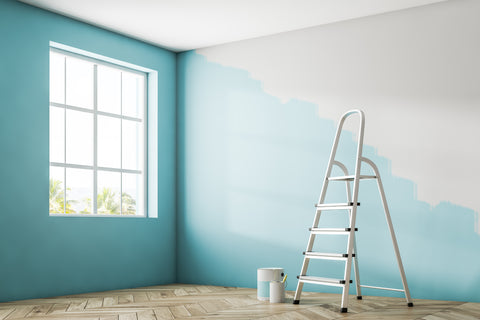
Restyle The Walls By Creating A Curated Wall Color Palette And Make Magic With Easy Painting Ideas:
- Consider The Color of the Fixed Elements in the Room.
- Choose Colors and Shades that Match the Decor Features.
- Use the Color Family When Selecting the Complementary Colors.
- Create A Seamless Color Story.
- Use Digital Color Apps For A Wall Preview.
- Let Lighting Decide The Tone.
While picking the right colors is just one part of the game, achieving a phenomenal look with a seamless painting job on your walls is another. Be the self-made artist and bring life and color into your room.
For more help choosing the right colors and easy-to-do wall painting ideas, read on.
1. How Do You Do Wall Painting Designs Yourself?
I) Accent Walls:
Accent walls have been in style for a long time.
Create accent walls with simple tools like cardboard, paper cups, masking tape, etc. Play around with colors and designs and make your walls into breathtaking art pieces.
Select a wall to make it into an accent wall. There is more than one creative way to make an accent wall. Pick the one that appeals most to you and works best for you.
One thing to remember when making accent walls is to make it stand apart from the rest of the walls –
- Achieve a classy look by choosing vibrant colors.
- Try a refined design or a bold pattern – that will go along well with your room’s decor elements.
- Work towards creating depth and visual interest in your space.
- Let the accent wall’s color play along with the colors of the other three walls.
Make your feature wall a stunner by trying out these accent wall ideas.
a) Brick Wall Accent:
Beautify your room by adding a brick wall as an accent wall.
This old vintage rustic charm stands out and is a sure heartwinner. Deck up one side of your room with the bricks (or create a mock-up brick wall).
To create a brick wall makeover,
- Use painter’s tape to create the brick wall design on your wall.
- Fill the rectangles with the desired paint color.
- Once dry, carefully remove the tape.
Your brick wall is gorgeous and beyond and will soon be the talk of the town.
Pro-Tip:
You don’t necessarily need to stick around the safe zone of red color for your brick wall. Instead, explore the unbeaten path and experiment with different colors to create unique brick wall art.
b) Colorful Stripes:
Is your wall looking too dull and plain? Try this trick to add charisma to your space without risking too much.
- Decide on the background color and paint it on your wall.
- Use a measuring tape to mark the lines.
- Apply masking tape over them.
- Once they are in place, paint the second color between the masking tape lines.
- Let it dry.
- Carefully remove the tape to reveal the crisp edges and a beautifully striped wall.
Since you are a novice at this, go for plain stripes for the first time.
Once confident and adept at using painter’s tape, venture boldly into horizontal, vertical, diagonal, or patterned stripes on your walls.
To create a stylish and playful pattern, experiment by alternating with two or more colors.
Remember to use good-quality masking tape. Otherwise, it will bleed into the borders, resulting in smudged lines.
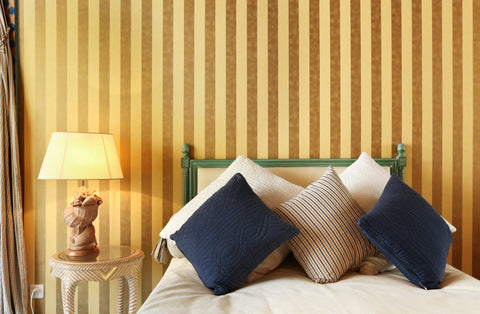
c) Geometric Shapes:
Not a great fan of stripes? Try the jazzy geometric shapes instead.
Cut out stencils with cardboard and use them to paint geometric shapes. Attention to detail and patience are needed to achieve a uniform look.
Just a gentle reminder:
Remember, your hands are surely going to get fatigued. So, be prepared to take as many breaks as possible and give ample rest to your tired hands while doing this project.
Try various colors and shapes, like triangles, hexagons, or rectangles. This simple yet artistic method incorporates a voguish touch to your space, giving it a contemporary feel.
d) Color Block Technique:
Try the color blocking technique if you are serious about touching up your space with an exotic color collection.
This method allows you to interestingly and innovatively add two or more colors to your walls.
The guidelines include meticulous prior planning and choosing colors from the opposite end of the color wheel. The knowledge of dividing the walls into different sections can be an added advantage.
The correct color selection is yet another accomplishment, as the color combo should click with each other.
This extreme makeover is a daunting task, so it is strictly not for beginners.
e) Two-Toned Walls:
Want to make your room appear bigger and taller? Paint a two-toned wall the horizontal way.
Choose to paint a darker bottom color, topping it up with a lighter shade. The light shade will go all the way up to the ceiling, creating a roomy look, while the darker shade will make your space feel more intimate and comfy.
Pick a complementary or contrasting color to create a two-toned wall for a unique and visually appealing wall.
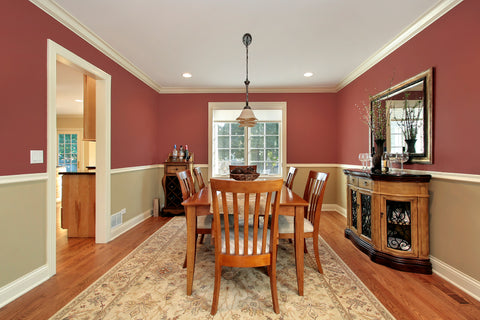
f) Make Your Favorite Stencils:
Stenciled design is an effortless way to fill your walls with intricate patterns or motifs in a jiffy.
You can design your stencil in an online studio or make one for yourself.
Once you have decided on your stencil design and color, it is time to start applying them.
- Position the stencil on the wall.
- Tape the sides of the stencil with tape so it stays put.
- Load the paint on the paintbrush and dab it on a paper towel to remove excess paint.
- Ensure the bristle tips are evenly coated before applying the paint on the wall.
- Use gentle but even strokes while filling in the stencil design.
- Once an area is stenciled, move the stencil to the adjacent space.
- Ensure you have aligned the registration correctly before doing the parallel design.
- Your beautifully stenciled wall pattern is now complete.
- Step back and enjoy!!!
g) Dip-Dye Effect:
Repaint your wall into a striking one!
This two-toned paint technique is effortless, but the outcome will amaze you.
Dip-dye walls are your go-to when your ceiling is high, and your furniture is plain.
Paint a darker color at the bottom that gradually bleeds into a lighter shade on the top, eventually vanishing off at the ceiling.
Recast your depressing ambiance into a cozy, inviting atmosphere.
It is suitable for a living room where people gather for time together at the end of the day.
h) Lacey Backdrop:
Are you ravingly mad about lace designs?
Roll and cover your favorite lace pattern on the paint roller and paint the lacey designs on your walls to satiate your lace cravings.
i) Starry Night Sky:
Do you love star gazing?
This fairy tale stunner is an excellent redo for kids’ rooms and bedrooms. After all, who doesn’t like an enchanting canopy of a star-studded sky?
Paint your walls to create a dark background, and add the stars using glow-in-the-dark paint.
Doze off watching a million stars and a romantic crescent moon on a dreamy night sky!
j) Color Wash Technique:
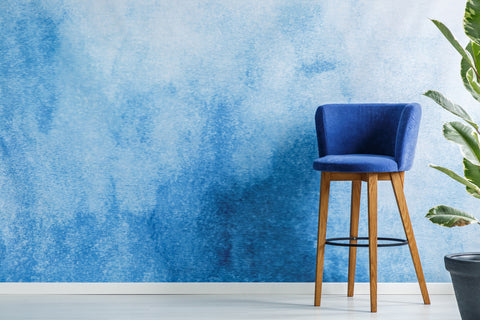
Create a unique water-colored appearance to your accent wall by painting your walls with the color wash technique. The aim here is to create an aged and weathered look to your walls, thus adding texture and depth to your walls.
To get a basic color wash look, choose two colors – one a bold color and the other one that blends well with the first one, say a lighter color.
- Pour both colors into your color tray side by side.
- In a single swipe, pick up both colors.
- Using the crosshatch technique, paint light, quick strokes on the wall.
- Avoid swirling or straight swipes.
- Spray a drizzle of water to merge the colors from time to time.
- Once the painting is over, use sandpaper to buff up the coat.
Your color-wash wall exhibits a translucent, watercolored impression. Use this technique to paint the whole room or just one (accent) wall.
II) Neutral Tones:
If you want to keep your walls toned down, go for pastel and neutral colors like beiges, grays, and other muted shades. They create a calming and relaxing effect in your home.
Whites in the color family is an all-time favorite and always stays in style.
If you’ve used whites all your life and still love them but crave a fresh look, here’s a suggestion. Add a tint of bluish, grayish, or greenish hue, complementing the decor elements in your space.
While opting for neutral tones, don’t opt for washed-down colors.
III) Dark Colors:
If you have ample room space, then Congratulations! You have the liberty of using dark colors in them. Pick a bold or dramatic dark color and allow the paint color to impact your space.
2. Which Paint Is Best Suited To Paint Designs On The Wall?
- Watercolor paint – Suitable for creating delicate, watercolor effects on the walls.
- Oil-based paint – Gives your walls a long-lasting, smooth, glossy finish. Apt when you want to create knotty designs. The only downside to this paint is it takes longer to dry.
- Texture paint – Helps you achieve 3D texture and character to your walls – a perfect fit for accent wall creation.
- Spray paint – Best suited when you want the paint job done quickly, saving time, effort, and money.
- Latex or acrylic paint – Appropriate for most painting requirements because of its versatility and durability. Use them for painting projects of all sorts.
- Metallic Paint: Make your statement wall dazzle with luxury and sophistication. Great for stenciled work and intricate designs. You can create wall glazes as well. The only disadvantage is it is expensive.
- Fabric paint: Use fabric paint to imitate the texture of the silky smoothness of fabric on your walls.
3. Does Every Wall Need To Be Decorated?
No, it’s not necessary.
Consider various factors like room function, decor balance, functionality, light, space, budget, etc., before decking up your walls.
Sometimes, it is best to leave the walls as is. For example, a stone wall is best left alone, and so is a brick wall.
For an accent wall to stay the centerpiece of attraction, it is best to leave the other walls plain. Otherwise, they can become a distraction and steer away the due attention that the focal wall deserves.
Leaving the walls plain or with minimalistic decoration works well for rooms with limited light and space. Too much clutter can smother a small zone. An open, airy feel with fewer elements is best for low-lit, small areas.
In spaces such as the kitchen and storage spaces, functionality overrules decor. If there is little opportunity to add decorative walls, it is better to refrain from them in such areas.
Sometimes, simple and clear walls create a calming effect instead of a crowded one. Spaces meant for relaxation are great examples. So, go minimalistic in such living areas.
4. How Do You Choose Colors To Go On The Walls Of Your Home?
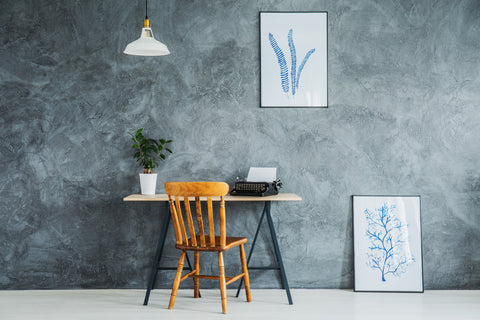
Keep these things in mind when you choose your color palette for the walls:
1. Choose Colors To Complement Existing Colors:
Look around your room. What colors do you see in the sofas, cabinets, furniture, tiles, etc.? These colors are permanent and cannot be changed. So, use them as base colors and find colors that go well with them.
2. Pick Colors Within The Color Family:
When choosing colors for your home, select the colors from the same color family as that of the preexisting colors in the room. Select either the hues of these colors or go for complementary colors.
3. Create A Seamless Color Story:
Let each room in your home resonate with each other. Paints are the best way to connect them.
For a well-connected look for the whole house, create a single color palette and use them to complement colors in every room.
4. Use Digital Color Apps For A Wall Preview:
Get a peek at what your home will look like after painting using the digital color apps available online. Trust me! These apps are a second pair of eyes and can be a lifesaver.
5. Let Lighting Decide The Tone:
Opt for a darker, richer shade if your room gets more natural light. If it is dull and gloomy due to lack of sunlight, go for a cooler, lighter tone.
6. Whites Never Goes Out Of Fashion:
Decking up your home to make it look gorgeous and dashing is easy with white.
Also, painting your house in white and undertones is a thrifty deal. Whites turn your rooms roomier, brighter, and livelier.
And what more! They are a perfect color option for any space you paint them with – from soft, muted whites to true whites.

